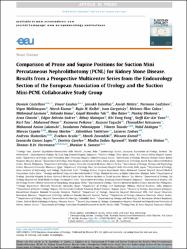Comparison of prone and supine positions for suction mini percutaneous nephrolithotomy (PCNL) for kidney stone disease: Results from a prospective multicenter series from the Endourology Section of the European Association of Urology and the Suction Mini-PCNL Collaborative Study Group

View/
Date
2025Author
Castellani, DanieleGauhar, Vineet
Kalathia, Jaisukh
Mehta, Amish
Gadzhiev, Nariman
Malkhasyan, Vigen
Kumar, Nitesh
Kalbit, Rajiv H.
Gorgotsky, Ivan
Gokce, Mehmet Ilker
Laymon, Mahmoud
Inoue, Takaaki
Tak, Gopal Ramdas
Baker, Abu
Dholaria, Pankaj
Chawla, Arun
Beltra´n-Sua´rez, Edgar
Mahajan, Abhay
Fong, Khi Yung
Yuen, Steffi Kar-Kei
Tan, Karl
Omar, Mohamed
Petkova, Kremena
Taguchi, Kazumi
Ketsuwan, Chinnakhet
Lakmichi, Mohamed Amine
Palaniappan, Sundaram
Tanıdır, Yılören
Akdogan, Nebil
Cepeda, Marcos
Martov, Alexey
Tokhtiyev, Zelimkhan
Tzelves, Lazaros
Skolarikos, Andreas
Acuna, Esteban
Zawadzki, Marek
Kamal, Wissam
Lopes, Leonardo Gomes
Gorelov, Dmitriy
Agrawal, Madhu Sudan
Mohan, Vaddi Chandra
Herrmann, Thomas, R.W.
Somani, Bhaskar K.
Metadata
Show full item recordCitation
D. Castellani, V. Gauhar, J. Kalathia et al., Comparison of Prone and Supine Positions for Suction Mini Percutaneous Nephrolithotomy (PCNL) for Kidney Stone Disease. Results from a Prospective Multicenter Series from the Endourology Section of the European Association of Urology and the Suction Mini-PCNL Collaborative Study Group, Eur Urol Focus (2025).Abstract
Background and objective: The optimal patient position for percutaneous nephrolitho tomy (PCNL) remains a matter of debate. Our aim was to evaluate the association
between prone versus supine positioning and perioperative and postoperative outcomes
of suction mini-PCNL.
Methods: In this prospective multicenter observational study, we analyzed data for 1534
patients treated in 30 centers between March and November 2024. Outcomes included
the stone-free rate (SFR) assessed via 30-d computed tomography, and complication
rates. Multivariable analysis was used to assess the effect of prone positioning on
stone-free status (zero fragments) and overall complications, with adjustment for other
covariates.
Key findings and limitations: There were 653 patients (43%) in the prone group and 881
(57%) in the supine group. Patient demographics were similar between the groups,
except for body mass index. In terms of Guy’s stone score, the prone group had a higher
proportion of score 1 stones (60% vs 47%) and the supine group a higher proportion of
score 4 stones (6.9% vs 3.2%). Median stone volume did not differ significantly, at
1636 mm3 in the supine group and 1725 mm3 in the prone group (p = 0.7). The prone
group had more frequent use of spinal anesthesia (68% vs 29%; p < 0.001),
fluoroscopy-only guidance (86% vs 61%; p < 0.001), and supracostal access (36% vs
22%; p < 0.001). Surgical time, pain scores, hospital length of stay, and readmission rates
were similar between the groups. Zero-fragment stone-free rates were comparable (85%
prone vs 81% supine; p = 0.052). Prone position was associated with higher rates of blood
transfusion (2.8% vs 0%; p < 0.001), renal pelvic perforation (2.8% vs 0.23%; p < 0.001),
and pneumothorax (1.5% vs 0%; p < 0.001). Multivariable analysis revealed that prone
positioning was not significantly associated with grade A stone-free status (odds ratio
0.92, 95% confidence interval [CI] 0.66–1.29; p = 0.6) or the overall complication rate
(odd ratio 0.87, 95% CI 0.59–1.28; p = 0.5). The nonrandomized study design may have
introduced selection bias and limited our ability to establish causal relationships
between variables.
Conclusions and clinical implications: Both prone and supine positioning for PCNL
achieved excellent SFRs with acceptable safety profiles.
Source
European Urology FocusURI
https://www.sciencedirect.com/science/article/pii/S2405456925002895?via%3Dihubhttps://doi.org/10.1016/j.euf.2025.10.003
https://hdl.handle.net/20.500.12780/1252
Collections
- Makale Koleksiyonu [12]

















